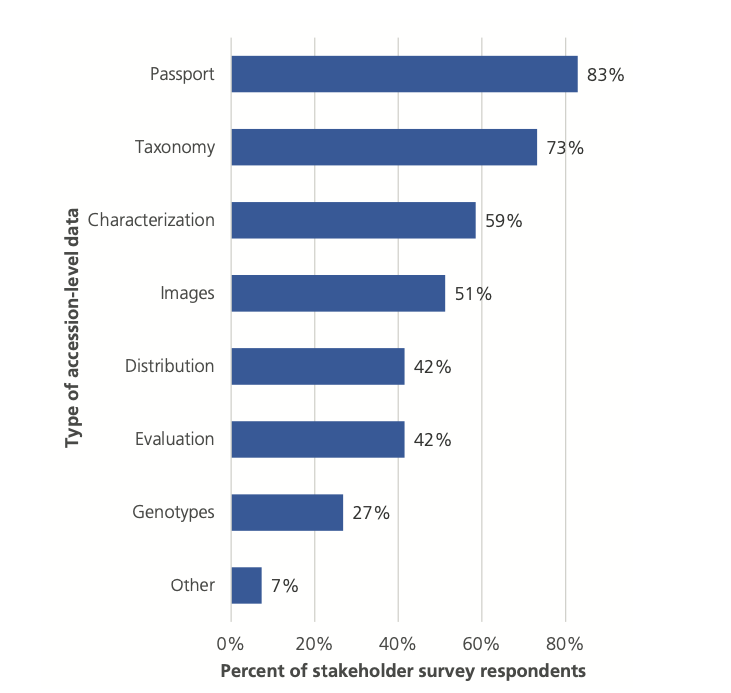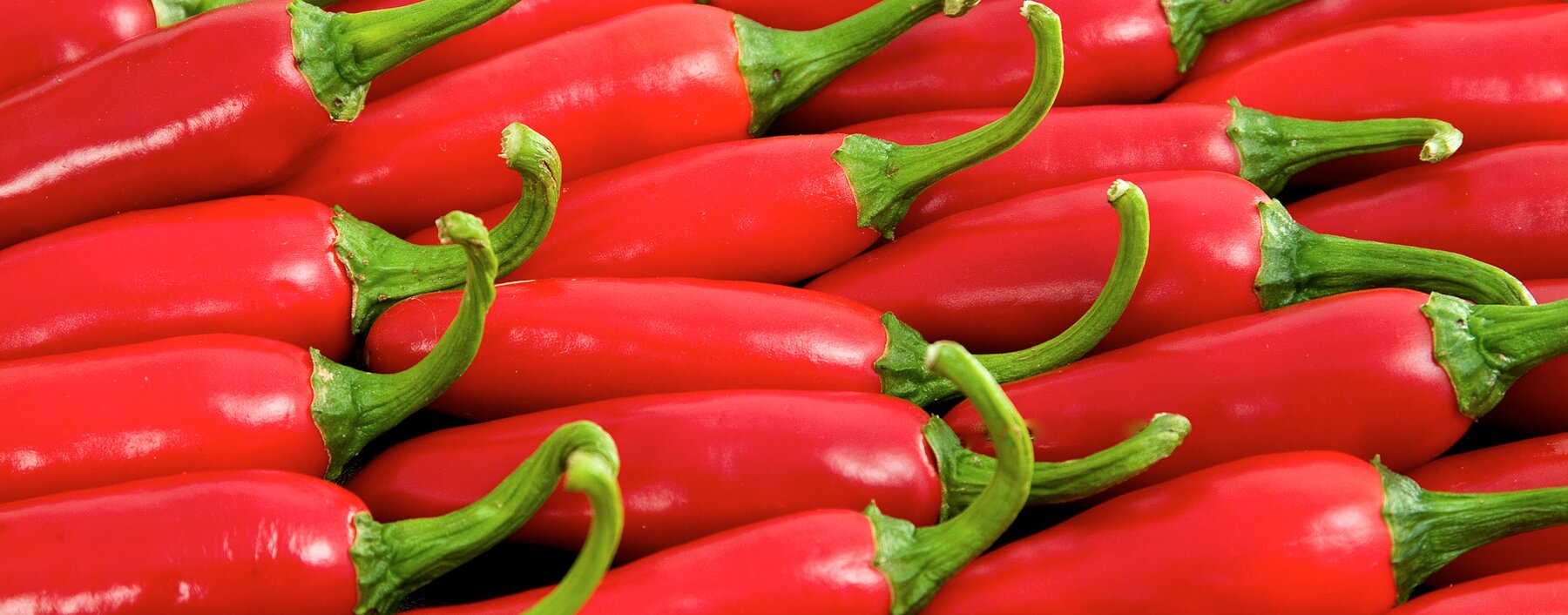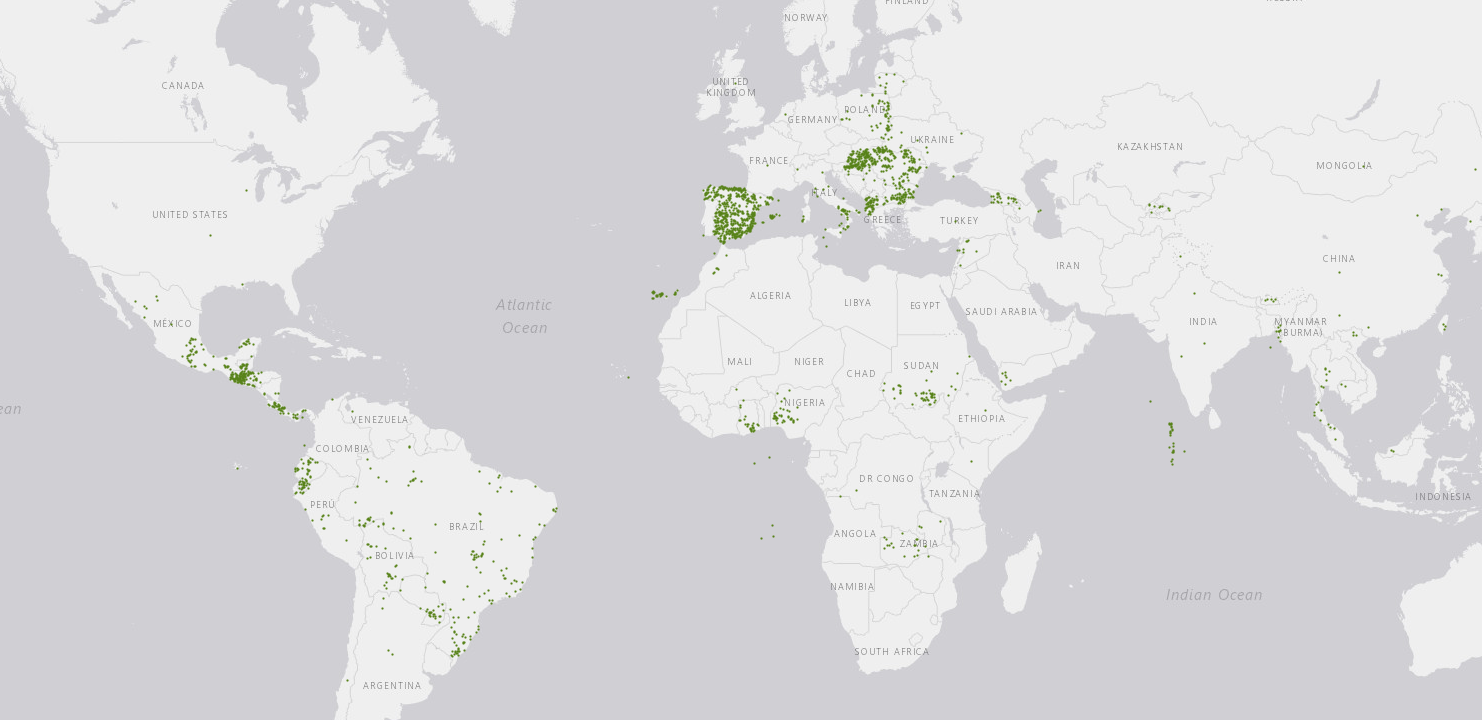A Global Strategy for the Conservation and Use of Capsicum Genetic Resources
A Global Strategy for the Conservation and Use of Capsicum Genetic Resources was published in 2022 (Global Crop Diversity Trust 2022). This document, developed with the input of a large number of experts, aims to provide a framework for the efficient conservation and effective use of globally important collections of Capsicum genetic resources. This webpage provides a summary of some of the its key findings and of the recommendations for priority actions.
Size of collections and their locations
Data from WIEWS, Genesys, GRIN-Global databases, and a survey indicated a total of over 50,000 Capsicum acessions conserved in genebanks at the global level. The interactive bubble map below shows the combined data retrieved in 2022 from Genesys and WIEWS.
Key collections
Some of the key Capsicum ex situ collections are:
- The World Vegetable Center (WorldVeg)
- The USDA Plant Genetic Resources Conservation Unit (USA)
- The Centre for Genetic Resources (Netherlands)
- The Leibniz Institute of Plant Genetics and Crop Plant Research (IPK)/Information and Coordina- tion Centre for Biological Diversity (IBV) (Germany)
- Embrapa (Brazil)
- New Mexico State University (USA)
- The Institute for Agrobotany (RCA)/Centre for Plant Diversity (Hungary)
- The Centro Agronómico Tropical de Investigación y Enseñanza (CATIE), the Departamento Nacional de Recursos Fitogenéticos (Ecuador)
- The Instituto Nacional de Innovación Agropecuaria y Forestal (Bolivia)
- The Research Centre for Vegetable and Ornamental Crops (Italy)
- The Taiwan Agricultural Research Institute (Taiwan)
- The National Agriculture and Food Research Organization Genebank (Japan), the Universitat Politècnica de València (Spain)
- The Corporación Colombiana de investigación Agropecuaria (AGROSAVIA) (Colombia)
- The Centre de Ressources Biologiques Légumes, Institut national de recherche pour l’agriculture, l’alimentation et l’environnement (INRAE) (France).
Note that this list should not be considered comprehensive of all collections with notable or important Capsicum diversity.
Capsicum accessions conserved ex situ by regions where they are stored
The bars show the number of accessions of cultivated and wild Capsicum species by regions where they are stored (i.e. the location of the genebanks).
Ex situ holding by biological type
The chart shows the number of Capsicum accessions by biological type. For a large proportion of accessions conserved in genebanks the passport data in the open databases do not include information on the biological type of the accessions. The data was retrieved in 2022 from Genesys, WIEWS and GRIN-Global databases.
Information and documentation
Approximately 60% of respondents to the surveys reported not having an adequate computerized database to manage the collection and share accession data, and, further, that their current system did not meet the needs of the institution or of the users of the collection. Approximately 21% of respondents who have a searchable electronic platform (computerized database) for storing and retrieving accession-level data, use the freely available Germplasm Resource Information Network (GRIN)-Global. The chart below shows the type of accession-level available among the genebanks that responded to the survey. The survey's responses indicate that while major Capsicum collections may have adequate computerized databases to manage their collections, many other institutions have inadequate software and computer infrastructure. On the other hand, it appears that considerable passport, taxonomy, and characterization data on Capsicum collections have already been generated, while there is less evaluation, genetic, and other pertinent data.

Percent of stakeholder survey respondents holding different types of accession-level data for their Capsicum collections
Capsicum diversity tree
A diversity tree is a stratification of a genepool into groups and subgroups. The concept originated in a paper published by van Treuren et al. (2009) proposing a way to analyze and plan the composition of genebank collections. The diversity tree visualization is interactive (click on the tree to open it).
Recommendations for priority actions
Capsicum diversity, genetic resource collections, and acquisition priorities
Of particular interest would be the identification of the progenitors of cultivated C. chinense, C. frutescens, and C. pubescens, if they still persist.
A second priority would be the completion of crossability and phylogenetic studies across all Capsicum taxa, which will be important for clearer establishment of clades, complexes, and genepool classifications within the genus.
Within the cultivated taxa, some further elucidation of patterns of varietal and genetic diversity is needed, for example for C. annuum in South and Southeast Asia, C. chinense in West and Central Africa and in parts of Asia, and C. frutescens in Africa and Asia.
Further collaboration in comparing accessions at the nomenclatural, phenotypic, and genetic levels will be needed to arrive at a clearer understanding of the distinctness of accessions and degree of duplication both within and among collections.
the wild species are generally extremely poorly represented ex situ, with only a few exceptions, i.e. C. annuum var. glabriusculum, C. chacoense, and potentially C. baccatum var. baccatum in terms of absolute number of accessions; C. cardenasii may also be considered fairly well represented in the context. Further collecting within taxonomic hotspots, namely Brazil, Andean countries, and parts of Mesoamerica are of particular importance and may provide an opportunity for efficient collecting of multiple taxa and ecotypes of coverage across its geographic range (Khoury et al. 2019). Further collecting of the remaining wild species, as well as of geographic and ecological gaps in even these aforementioned wild relatives, is clearly needed to improve their representation in ex situ conservation and their availability and accessibility for research, including for plant breeding.
Structure, management, and conditions of Capsicum collections
Further efforts should certainly be made to ensure presence in long-term infrastructure for all distinct accessions, either at their current sites or through duplication at institutions with the appropriate infrastructure. Likewise, further efforts to improve storage materials (e.g. aluminium packets) and processes (i.e. temperature and humidity standards) should be made for collections not currently following optimum practices.
There is a clear and pressing need to study the multitude of factors contributing to loss of viability for all Capsicum species in storage and to develop a set of standards to ensure best practices.
Regeneration and multiplication of Capsicum genetic resources
Further efforts are clearly needed to reduce the number of accessions urgently needing regeneration.
Documentation and information sharing on Capsicum genetic resources
Further efforts are needed to provide up-to-date information on Capsicum collections through global databases such as Genesys and FAO WIEWS.
Use of Capsicum genetic resources
Improving access to Capsicum genetic resources is not simple or straightforward, as it is often linked to national and institutional policy which is largely outside the responsibilities and power of Capsicum genetic resources practitioners. All efforts to motivate more open sharing of these resources are important, including by advocating for the inclusion of Capsicum within Annex 1 of the ITPGRFA, based on its clear international importance.
In situ conservation of Capsicum genetic resources
The lowest hanging fruit for improving the conservation of the wild species is through the confirmation of the persistence of such populations, and of population sizes likely to be viable under current and projected future pressures, within existing protected and other open space areas, and subsequently through the development of active management plans for pop- ulations within these areas.
Threats to landraces are less well understood but should be assumed to be real and increasing in most regions. Improving in situ (on farm) conservation of these resources is challenging as farmers necessarily balance several priorities critical to their livelihoods, the conservation of genetic diversity being only one (if at all)
Partners and donor
The development of this crop conservation strategy was funded by the German Federal Ministry of Food and Agriculture (BMEL) as part of the three-year project led by the Crop Trust: Breathing New Life into the Global Crop Conservation Strategies: Providing an Evidence Base for the Global System of Ex Situ Conservation of Crop Diversity. The Crop Trust also cooperated with the Secretariat of The International Treaty on Plant Genetic Resources for Food and Agriculture (ITPGRFA) in the development of this document.





